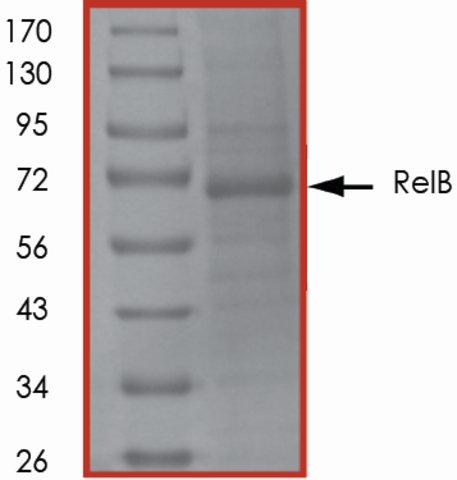您的位置:首页 > 产品中心 > Rel B, His tagged human
Rel B, His tagged human

| 产品编号: | 4140300 |
| 规格: | recombinant, expressed in baculovirus infected Sf9 cells, ≥70% (SDS-PAGE), buffered aqueous glycerol solution |
| 包装规格: | 50 μG |
| 产品类别: | 进口试剂 |
| 品牌: | Sigma-Aldrich |
| 优惠价: | 立即咨询 |
产品别名
Rel B, His tagged human
IREL
I-Rel
基本信息
| NACRES | NA.32 |
| General description【一般描述】 | Rel B is part of the NFκB complex and forms heterodimeric complexes with p50 (NFKB1) and p52 (NFKB2). The homodimeric complexes of Rel B alone do not show DNA-binding activity. IHC analysis has shown that Rel B expression correlated with dendritic cell activation. NFκB-inducing kinase NIK is required for osteoclastogenesis in response to pathologic stimuli and overexpression of Rel B rescues differentiation of mouse NIK -/- osteoclast precursors. Rel B is required for RANKL-induced osteoclastogenesis in vitro and for TNF -induced bone resorption in vivo. This indicates that the alternative NFκB pathway, via Rel B, plays an essential and unique role in RANKL signaling toward osteoclast development. |
| Physical form【外形】 | Supplied in 50mM sodium phosphate, pH 7.0, 300mM NaCl, 150mM imidazole, 0.1mM PMSF, 0.25mM DTT, 25% glycerol. |
| Preparation Note【制备说明】 | after opening, aliquot into smaller quantities and store at -70 ℃. Avoid repeating handling and multiple freeze/thaw cycles |
产品性质
| recombinant【重组】 | expressed in baculovirus infected Sf9 cells |
| Assay【测定】 | ≥70% (SDS-PAGE) |
| form【形式】 | buffered aqueous glycerol solution |
| mol wt【分子量】 | ~68 kDa |
| NCBI accession no.【NCBI登记号】 | NM_006509 |
| shipped in【运输】 | dry ice |
| storage temp.【储存温度】 | −70℃ |
| Gene Information | human ... RELB(5971) |
安全信息
| Pictograms【象形图】 | GHS07,GHS08 |
| Signal word【警示用语:】 | Danger |
| Hazard Statements | H315 - H319 - H360D |
| Precautionary Statements | P202 - P264 - P280 - P302 + P352 - P305 + P351 + P338 - P308 + P313 |
| Hazard Classifications【危险分类】 | Eye Irrit. 2 - Repr. 1B - Skin Irrit. 2 |
| Storage Class Code【储存分类代码】 | 6.1C - Combustible, acute toxic Cat.3 / toxic compounds or compounds which causing chronic effects |
| WGK | WGK 1 |




